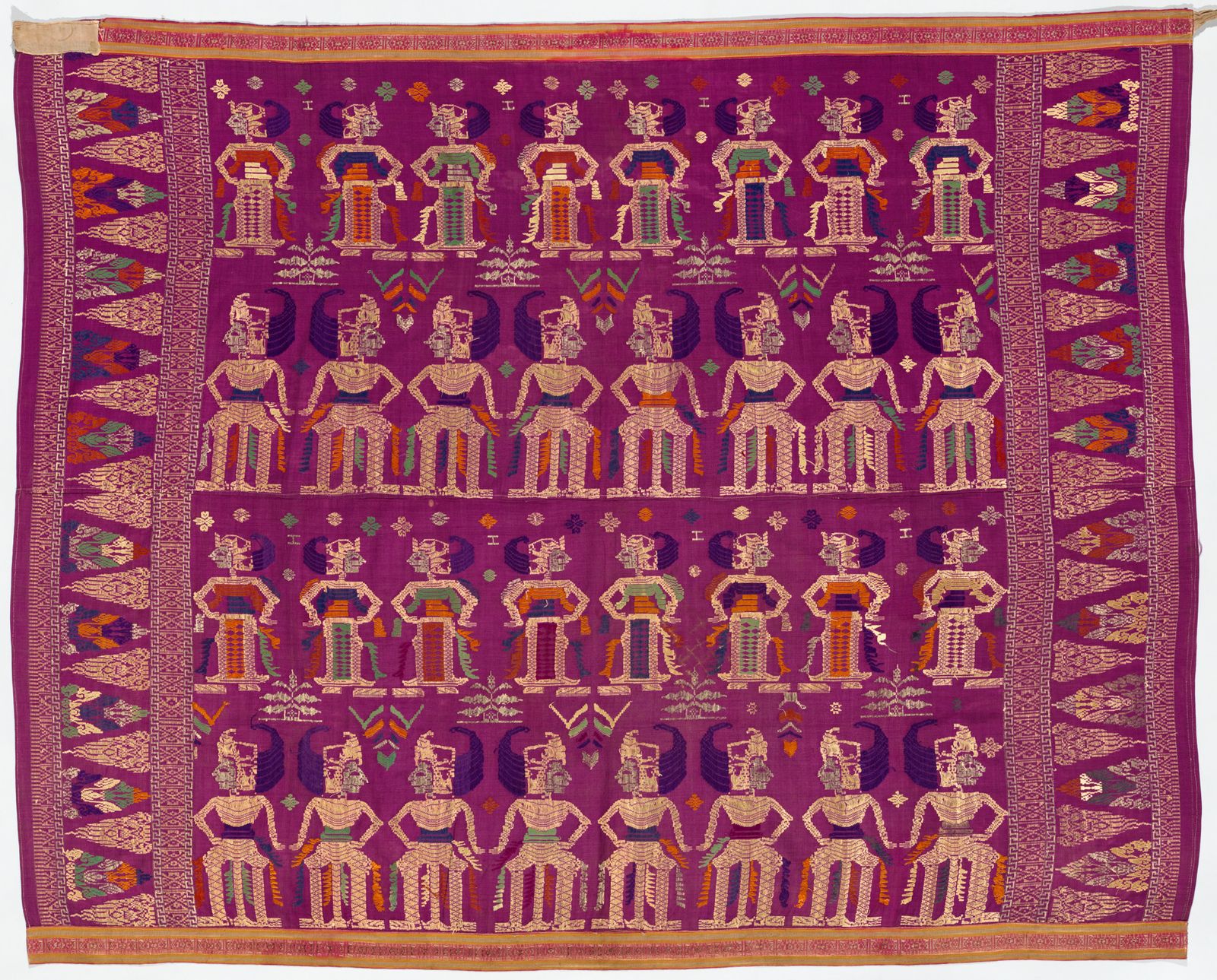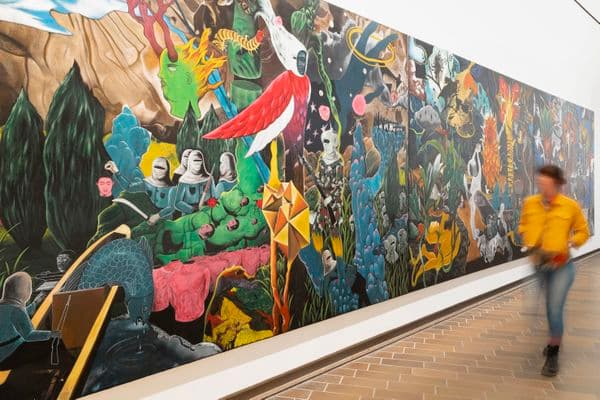Indonesian Textiles

Balinese people, Nobleman's ceremonial over wrap [kampuh songket or saput songket], late 19th century, National Gallery of Australia, Kamberri/Canberra, Purchased 1989.
About
The National Gallery of Australia holds one of the richest public collections of Indonesian textiles in the world. Thanks to the generous assistance of the Australia-Indonesia Institute (AII), the extensive collection of over 1200 works is accessible to scholars, researchers and textile enthusiasts across the globe through this website.
A major undertaking, all of the textiles have been studio photographed in colour and digitised. Catalogue information has been reviewed and updated to include recent research on textile origins.
The support of the Australia Indonesia Institute has ensured that the National Gallery of Australia's splendid collection is permanently documented – and, importantly, the project reinforces the Gallery's commitment to enhancing public access to the national collection. It is envisaged that 'virtual' access will encourage further scholarship and interest in what is arguably Indonesia's most significant form of artistic expression.
The original site for Indonesian textiles has been archived, allowing works to be browsed by region.
Glossary
Indonesian Textile Techniques
Appliqué – the application of an accessory fabric, or other objects such as sequins, onto a ground fabric, usually by stitching, for patterning purposes. Shadow appliqué refers the process whereby a translucent accessory fabric is stitched in place allowing the ground fabric to remain visible beneath. Patterning effects of appliqué vary from abstract geometric designs to bold, figurative motifs.
Batik – batik textiles are created by applying molten wax to the smooth surface of finely woven cotton cloth. On setting, the wax resist prevents the cold dyes from entering areas of the design to which it has been applied. The wax is then scraped and boiled off. To create a complex batik pattern the process of waxing and dyeing may be applied a number of times. On the finest and most valuable batik textiles, the molten wax is applied with a fine pen-like instrument known as a canting. In the mid-19th century the development of a metal stamp known as the cap allowed for a faster though less flexible waxing of designs. The most refined batiks are waxed equally on both sides of the fabric and are thus completely reversible. Hand-drawn batik is largely the art of women, while it is only men who create the commercial batik cap.
In Indonesia today, batik is exclusively carried out on the island of Java, and it has long been exported to other parts of the Indonesian archipelago where it is much admired. The colour and designs vary from one batik region of Java to another.
Bead weaving – the threading of small beads on to the weft yarn before they are woven with the warp yarns.
Bead-work – a general term referring to the application of beads to a ground fabric for decorative purpose. The beads may be applied individually or as strips of beads, sewn or glued into place. Red, black and white beads are common in several regions of Indonesia, while prized shell beads and ancient glass beads were traded from coastal areas and distant lands. In the case of some textiles it is the applied beads that embody the greatest protective power – when the fabric becomes worn or damaged the bead-work is removed and re-applied to a new cloth. Bead-work may be applied randomly as simple decoration, in highly symbolic geometric formations or in bold, expressive figurative forms.
Block printing – the use of carved wooden blocks to apply mordants or resist substances, such as hot wax, to the surface of a woven cloth prior to dyeing.
Brocade – a general term referring to a woven fabric patterned by using supplementary threads. The term is usually applied to silk fabric richly patterned with gold or silver weft thread.
Couching – a method of embroidery in which decorative yarns are laid on the surface of a textile and then tacked in position with small stitches.
Embroidery – stitching is applied to the base fabric after weaving to decorate or embellish a fabric, usually by means of needlework. The stitch type is variable with the most common types including satin stitch and chain stitch.
Geringsing – sacred double ikat cotton textile woven only in Tenganan Pageringsingan, Bali. The geringsing is considered the most magical and powerful of all Balinese fabrics and is highly valued for ritual use. The geringsing is used by the nobility of Bali during important ceremonial rites, such as tooth-filing, for funerals and as part of the offerings made to the gods. The cloth is also used to treat people in times of sickness, when a small fragment of the cloth is sometimes removed and burned during a curative rite. In Balinese gering refers to illness or evil coming from the sea to the south of Bali or from Nusa Penida which lies off the coast, the realm of a powerful spirit associated with cholera and other epidemics, and sing means without.
Gold leaf gluework [prada or telepok] – gold leaf is added to different types of fabric to create a luxury object for ceremonial occasions. The technique is widely known in Indonesia as prada (or pinarada), and sometimes as telepok. In this royal textile it is applied to a hand-drawn cotton batik. In other instances it embellishes plain fabric, tie-dyed and stitch-dyed silks, Indian trade textiles and even ikat cloth.
The gold is attached to the smooth surface of the cloth with a liquid adhesive, often a fish-glue. The glue patterns are first hand-drawn or stamped onto the cloth with wooden blocks, and then the fine gold leaf or gold dust is applied, adhering only to the gluework design. Unlike most Indonesian textile techniques, gold-leaf prada was the work of men.
Ikat – the distinctive look of an ikat cloth is achieved by tying and dyeing patterns onto the threads before they are placed onto the loom and woven.
Warp ikat – for warp ikat, the threads that will be placed on the loom to become the warp are carefully measured before being grouped into small bundles. The parts of the pattern that the weaver wants to remain undyed are tightly tied with a resist fibre such as palm-leaf, waxed cotton string, or, today plastic raffia, before immersing the bundles in the dye. This process may be repeated by opening and closing some of the resist patterns before dyeing in another colour.
Weft ikat –the weft threads that will be interwoven into a plain warp set up on the loom during the weaving process are resist dyed. The weft threads are carefully measured out on a frame that is the exact width of the intended textile. The threads are then grouped into small bundles. The parts of the pattern that the weaver wants to remain undyed are tightly tied with a resist fibre such as palm-leaf, string or plastic raffia, before the threads are immersed in the dyes. This process may be repeated by opening and closing some of the resist patterns before dyeing in another colour. Some additional small areas of colour are sometimes painted onto the patterned weft threads before all the bindings are removed.
Double Ikat – the most difficult ikat technique, both the warp and weft threads are pre-dyed. The technique has traditionally only been practised in Gujarat in west India, where the silk patola is created, and in Tenganan in east Bali, where the famous cotton geringsing is woven. During the weaving process the weaver takes great care to align the motifs as the final design takes form. The loom is set up so that both the warp and the weft are visible on the final woven cloth. The cloth is reversible with the designs appearing equally clearly on both sides of the cloth. While the sombre Balinese double ikat geringsing are always woven from hand-spun cotton, the brightly coloured double ikat patola (singular, patolu) from Gujarat are always made of silk. In this case the usual sari size has been modified to suit Indonesian use and the open weave is typical of some export patola.
Mirror work – thin pieces of mirror glass, often lead-backed, or slivers of mica, are sewn onto a base fabric using a framework of stitches.
Mordant – a chemical which, when combined with a dye, causes the colour to fix to the fabric.
Mordant painting and printing – many of the Indian cotton textiles traded to Indonesia were decorated by a technique in which mordants, the chemicals that fix the dyes, were applied to the surface of the cloth before dyeing. In this process, the application of chemically different liquid mordants – either with a series of carved wooden blocks or a slim pen-like instrument – resulted in design elements of different colours appearing when combined with the same dye substance. The famous Indian natural alizarine red dyes used in this process were renowned for their colourfastness and brilliant colours. In some examples, block-printed iron oxide mordants created black dyes and potassium oxide led to bright red colour, whilst other substances and combinations resulted in browns and purples.
Plangi; pelangi – a resist tie-dyeing process. Patterns are usually built up from small circles.
Patola – the brilliantly coloured Indian cloths known as patolu (known by its plural form, patola, throughout Indonesia) are created by the intricate double ikat technique. The patola quickly became a symbol of high status and a clan treasure. While popular motifs include eight-pointed stars and large elephants, in recent years, previously undocumented patterns have emerged although the same designs were already well-known on Indian cotton block-printed cloths.
Songket – a term popular in Indonesia referring to textiles which include gold or silver wrapped thread as the major supplementary weft element. The wearing of textiles woven in gold-wrapped thread and expensive imported silk was the prerogative of the aristocracy throughout insular and peninsular Southeast Asia. The custom of wearing luxurious clothing as a symbol of power and high rank was probably established in the first millennium AD, when Hindu and Buddhist kingdoms dominated the region. These textiles remain a status symbol in Hindu Bali and this textile form was also adopted by many Islamic regions in Indonesia.
Stitch-resist dyeing – a resist dyeing process in which designs are made by sewing and gathering the textile before dyeing. This technique is known as tritik.
Supplementary warp or weft – in a woven fabric usually two sets of threads, the warp or vertical threads and the weft or horizontal threads, are interlaced. During weaving a further group of threads may be introduced in either direction: these extra threads are known as a supplementary warp or weft. They provide a decorative element on the textile surface and often appear as groups of long strands or floats creating blocks of colour, patterns and motifs. The technique of supplementary weaving is used throughout Indonesia, most spectacularly on the silk textiles made for the region’s courts. Intricate brocades are created with supplementary weft patterns in gold and silver metallic thread, and is widely known as songket. Some important hand-spun cotton textiles are also decorated with supplementary threads. Among the best known are the tampan and palepai shipcloths of Lampung, where ship and animal motifs are created with floating supplementary cotton wefts.
Supplementary weft wrapping – discontinuous coloured wefts are wrapped around plain warp. In Borneo this method is known as sungkit.
Tritik – see stitch-resist dyeing.
Twill weave – weaving or cloth patterned by a regular diagonal alignment of floating threads.
Twining – two or more weft (or warp) elements are worked together by spiralling round each other while encircling successive warps (or wefts).









//national-gallery-of-australia/media/dd/images/sadan_textile.jpg)

